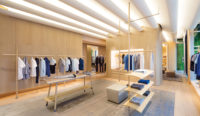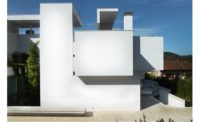A discreet 11-room boutique hotel in the tiny village of Pella (population 1,000) on the serenely beautiful Lake Orta, north of Milan, may look unassuming. Yet Casa Fantini—where a protected white-stuccoed house, over 200 years old, has been melded sympathetically to a new three-story concrete-framed bar-shaped structure—is a catalyst in the regeneration of this picturesque enclave, home to Fratelli Fantini, manufacturers of high-design bathroom fixtures. When the CEO Daniela Fantini took over the company after her father’s death in 1990, there was no place for business guests to stay in the village or many touristic amenities. Fantini decided to change that, with a hotel that accommodated both business-related visitors and vacationing guests. “The main landmark in the town has been an ice cream shop located in a historical tower,” she says. “Our hotel will give added value and attract more tourism. We live in a beautiful place—it influences the design of Fantini products. We wanted to express that in the hotel as well.”
Logically, she turned to the creative force behind some of the company’s products, plus its graphics and branding—Piero Lissoni, who is also an architect and has designed a number of striking hotels, such as the recently opened Mamilla in Jerusalem. Lissoni’s guiding principle was that the architecture needed to be both new and elegant, like Fantini products, but defer to the historic character of the town, enhancing its idyllic lakeside setting.
Additional Content:
Jump to credits & specifications
A strong sense of place stems from the location: the property commands entrancing views across the lake to the better-known town of Orta San Giulia (population 1,200) with its assortment of medieval, Renaissance, and Baroque architecture. Casa Fantini also looks out to the Isola San Giulio in the middle of the lake—which, in any sweepstakes for “most picturesque,” would have to come out on top—dominated by the Romanesque tower of the Basilica di San Giulio and an 1840s Benedictine abbey for nuns.
Lissoni happily took on the renovation and expansion of the old house and the construction of a new wing where some less prized buildings previously stood. While on its own, designing two levels of guest rooms above a ground-floor lobby, dining room, and separate bar may not seem to be a sizable commission, Lissoni embarked at the same time on remodeling and redesigning the neighboring low-rise Fantini factory. The crisply defined spaces are now nearing completion.
With the 12,200-square-foot hotel, Lissoni obviously wanted to capitalize on the view and introduce ample daylight to its interiors. But also important to the architect was integrating a sense of history with modernity in the solution. “We try to reflect a special sensibility that relies on a sophisticated memory,” says Lissoni, who intends to create the aura of the past rather than just imitate it. He mixed new and old in his employment of natural materials and craftsmanship, on the one hand, and the use of modern construction techniques and precision detailing on the other, throughout the building and its interiors.
With the structure, Lissoni kept the concrete floor slabs very thin and cantilevered them to support and shade the guest room balconies. Inside, the concrete bearing walls are placed on the ground floor so that they appear more like partitions within a flowing open space than a squadron of piers—an arrangement that also helps with earthquake stabilization, Lissoni says.
As for the exterior cladding, Lissoni chose a local accoya wood with a dark-hued, textured surface. The process for finishing the wood sounds like a recipe from The Alice B. Toklas Cookbook: the accoya is steeped in vinegar, burned, cleaned with brushes, and specially cut to create a refined version of vertical boards and battens with a pattern of horizontal striations. The effect is stunning. Local fieldstone walls enclose and define various spaces in a cadenced rhythm; they form outdoor rooms around the lushly planted gardens and the pool, exemplifying the mastery of the local masons.
While the bar is open to the general public, the small dining room is reserved for those staying at Casa Fantini. In order to separate the public from the private, hotel guests enter through a gate at one end of a stone wall and walk into a luxuriant garden before coming to an understated entrance. Once inside, they find themselves in a domestically scaled pavilion open to nature: glass walls overlook the front garden and, at the back, floor-to-ceiling glazing reveals a light well with plantings, edged by a stone wall.
The interior’s coolly minimal white plaster walls and ceilings are warmed by ebonized wood floors, carpets, and a combination of sleek and rustic furniture: farmhouse tables alternate with glass-and-steel ones in the dining room; comfortable upholstered sofas and chairs are mixed with pieces by Eames, Sottsass, Saarinen, and Castiliglione. “I like the contamination between different elements, so you don’t feel as if you are living inside a stupid catalogue,” Lissoni says. Similarly, the public Blu Lago bar is a crisply modern space where a plain wood refectory table sits under a gracefully dramatic 1940s copy of an 18th-century Austrian chandelier.
White plaster walls throughout the public and private areas are often unadorned except for such quirky additions as a stretch of peeling shutters (also white) mounted above the beds in the guest rooms. Elsewhere, shelving and tables contain intriguing found objects such as pots, bottles, sculptures, and other artifacts, arranged and selected by Lissoni’s consultant Elisa Ossino Studio. The effect is deliberately uncluttered: nothing distracts from the serenity of the environment.
With the guest rooms, the view is also everything: a single-loaded floor plan allows the nine narrow rooms on two upper floors of the new wing to face the front garden and the lake. Lissoni wrapped the bathrooms and closets at the back of each guest room in dark blue glass that subtly reflects the view of the water. The architects also gutted the older house to make room for two suites, one per floor, which take in the full waterside panorama, also reflected in the dark blue glass enclosing the interior spaces.
Fantini describes the feeling that the hotel strives to attain for its guests as “lake time,” where “you come to contemplate, read, draw, relax.” She herself seems to be on Milan and New York time (where the Fantini company has showrooms) but is always paying close attention to detail, to create a palpably soothing domestic atmosphere here in Pella. Her architect’s mix of old and new, outward warmth and underlying rigor, bolsters her vision. Fantini has provided the town with a worthy landmark that seamlessly interweaves impeccable and sensitive architecture, interior design, and landscaping to enrich the charm of this lakeside settlement.
CreditsArchitect: Personnel in architect's firm who should receive special credit: arch Samuel Lorenzi, arch Paolo Volpato, arch Fabrizia Bazzana arch Ricardo Hernandez, Ilia d'Emilio, Roberto Berticelli, Marco Guerini
Styling: Elisa Ossino Studio
Studio Iorio srl
Giardini Paghera www.paghera.com/
photos © Giovanni Gastel |
Specifications
Metal frame: Secco Sistemi https://www.seccosistemi.com/it/
Sliding doors: Sky-Frame https://www.sky-frame.com/it-it/
Mutina for ceramics www.mutina.it
Interior ambient lighting: Flos https://flos.com Downlights: Flos Exterior: Flos Dimming system or other lighting controls: Ekinex https://www.ekinex.com/ |
















Post a comment to this article
Report Abusive Comment